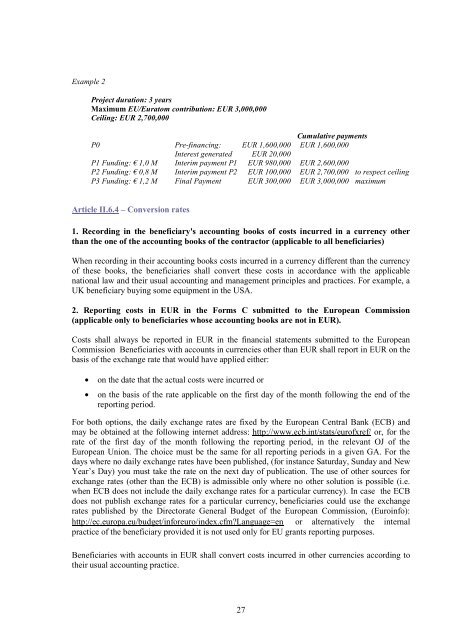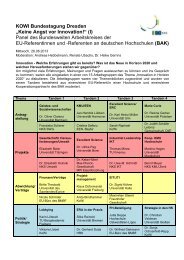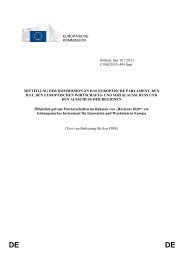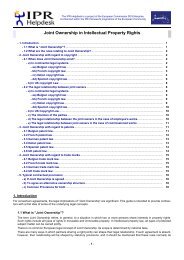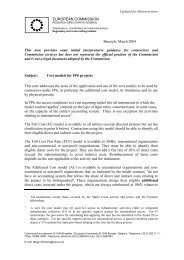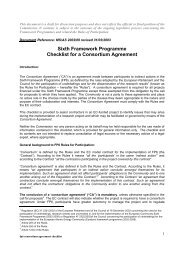Guide to Financial Issues relating to FP7 Indirect Actions - KoWi
Guide to Financial Issues relating to FP7 Indirect Actions - KoWi
Guide to Financial Issues relating to FP7 Indirect Actions - KoWi
You also want an ePaper? Increase the reach of your titles
YUMPU automatically turns print PDFs into web optimized ePapers that Google loves.
Example 2<br />
Project duration: 3 years<br />
Maximum EU/Eura<strong>to</strong>m contribution: EUR 3,000,000<br />
Ceiling: EUR 2,700,000<br />
Cumulative payments<br />
P0 Pre-financing: EUR 1,600,000 EUR 1,600,000<br />
Interest generated EUR 20,000<br />
P1 Funding: € 1,0 M Interim payment P1 EUR 980,000 EUR 2,600,000<br />
P2 Funding: € 0,8 M Interim payment P2 EUR 100,000 EUR 2,700,000 <strong>to</strong> respect ceiling<br />
P3 Funding: € 1,2 M Final Payment EUR 300,000 EUR 3,000,000 maximum<br />
Article II.6.4 – Conversion rates<br />
1. Recording in the beneficiary's accounting books of costs incurred in a currency other<br />
than the one of the accounting books of the contrac<strong>to</strong>r (applicable <strong>to</strong> all beneficiaries)<br />
When recording in their accounting books costs incurred in a currency different than the currency<br />
of these books, the beneficiaries shall convert these costs in accordance with the applicable<br />
national law and their usual accounting and management principles and practices. For example, a<br />
UK beneficiary buying some equipment in the USA.<br />
2. Reporting costs in EUR in the Forms C submitted <strong>to</strong> the European Commission<br />
(applicable only <strong>to</strong> beneficiaries whose accounting books are not in EUR).<br />
Costs shall always be reported in EUR in the financial statements submitted <strong>to</strong> the European<br />
Commission Beneficiaries with accounts in currencies other than EUR shall report in EUR on the<br />
basis of the exchange rate that would have applied either:<br />
• on the date that the actual costs were incurred or<br />
• on the basis of the rate applicable on the first day of the month following the end of the<br />
reporting period.<br />
For both options, the daily exchange rates are fixed by the European Central Bank (ECB) and<br />
may be obtained at the following internet address: http://www.ecb.int/stats/eurofxref/ or, for the<br />
rate of the first day of the month following the reporting period, in the relevant OJ of the<br />
European Union. The choice must be the same for all reporting periods in a given GA. For the<br />
days where no daily exchange rates have been published, (for instance Saturday, Sunday and New<br />
Year’s Day) you must take the rate on the next day of publication. The use of other sources for<br />
exchange rates (other than the ECB) is admissible only where no other solution is possible (i.e.<br />
when ECB does not include the daily exchange rates for a particular currency). In case the ECB<br />
does not publish exchange rates for a particular currency, beneficiaries could use the exchange<br />
rates published by the Direc<strong>to</strong>rate General Budget of the European Commission, (Euroinfo):<br />
http://ec.europa.eu/budget/inforeuro/index.cfm?Language=en or alternatively the internal<br />
practice of the beneficiary provided it is not used only for EU grants reporting purposes.<br />
Beneficiaries with accounts in EUR shall convert costs incurred in other currencies according <strong>to</strong><br />
their usual accounting practice.<br />
27


